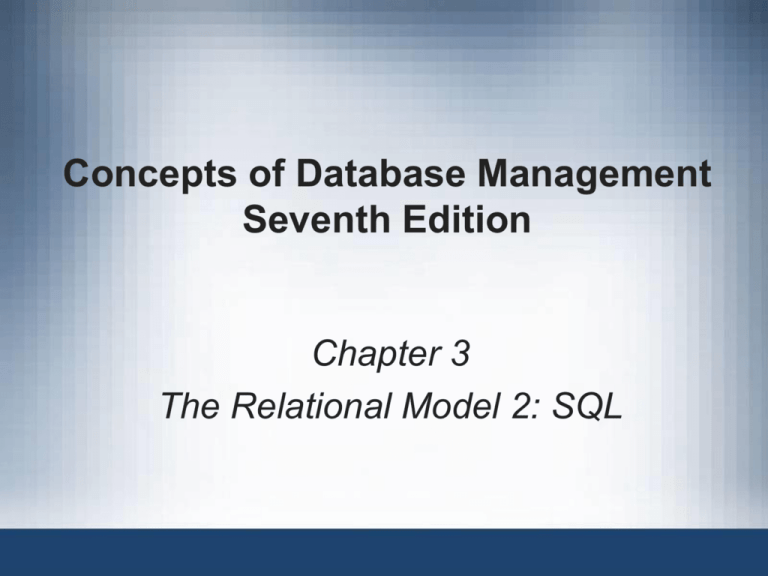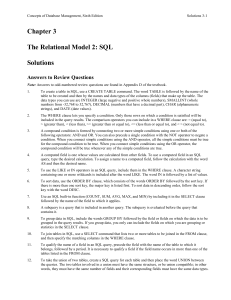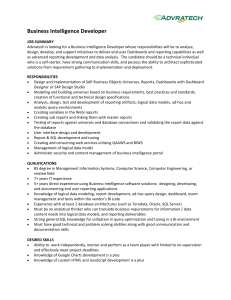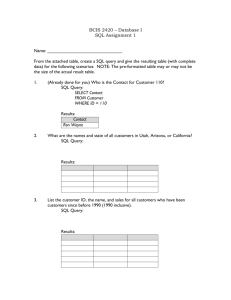ch03_CE - MVNU Computer Science Department
advertisement

Concepts of Database Management
Seventh Edition
Chapter 3
The Relational Model 2: SQL
Objectives
•
Introduce Structured Query Language (SQL)
•
Use simple and compound conditions in SQL
•
Use computed fields in SQL
•
Use built-in SQL functions
•
Use subqueries in SQL
2
Objectives (continued)
•
Group records in SQL
•
Join tables using SQL
•
Perform union operations in SQL
•
Use SQL to update database data
•
Use an SQL query to create a table in a database
3
Introduction
•
SQL (Structured Query Language)
– Allows users to query a relational database
– Must enter commands to obtain the desired
results
– Standard language for relational database
manipulation
4
Getting Started with SQL
•
If you are completing the work in this chapter using Microsoft Office
Access 2007, Microsoft Office Access 2010, or MySQL version 4.1 or
higher, the following sections contain specific information about
your DBMS
5
Getting Started with Microsoft Office
Access 2007 and 2010
•
If you are using the Access 2007 or 2010 version of the Premiere
Products database provided with the Data Files for this text:
– Tables in the database have already been
created
– You will not need to execute the CREATE
TABLE commands to create the tables or the
INSERT commands to add records to the
tables
6
Getting Started with Microsoft Office
Access 2007 and 2010 (continued)
•
To execute SQL commands shown in the figures in Access 2007 or
Access 2010:
– Open the Premiere Products database
– Click the Create tab on the Ribbon
– Click the Query Design button in the Other
group
– Click the Close button in the Show Table
dialog box
– Click the View button arrow in the Results
group on the Query Design Tools tab, then
click SQL View
– The Query1 tab displays the query in SQL
7
Getting Started with MySQL
•
MySQL-Premiere script provided with the Data Files for this text will:
– Activate the database
– Create the tables
– Insert the records
•
To run a script in MySQL:
– Type the SOURCE command followed by the
name of the file
– Press the Enter key
8
Getting Started with MySQL
(continued)
•
Before typing commands in MySQL, you must activate the database
by typing the USE command followed by the name of the database
•
The most recent command entered in MySQL is stored in a special
area of memory called the statement history
9
Table Creation
•
SQL CREATE TABLE command
– Creates a table by describing its layout
•
Typical restrictions placed on table and column names by DBMS
– Names cannot exceed 18 characters
– Names must start with a letter
– Names can contain only letters, numbers,
and underscores (_)
– Names cannot contain spaces
10
Table Creation (continued)
•
INTEGER
– Number without a decimal point
•
SMALLINT
– Uses less space than INTEGER
•
DECIMAL(p,q)
– P number of digits; q number of decimal
places
•
CHAR(n)
– Character string n places long
•
DATE
– Dates in DD-MON-YYYY or MM/DD/YYYY form
11
Table Creation (continued)
CREATE TABLE Rep ( RepNum CHAR( 2) , LastName CHAR( 15) ,
FirstName CHAR(15) , Street CHAR(15) , City CHAR( 15) ,
State CHAR(2) , Zip CHAR( 5) , Commission DECIMAL(7, 2) ,
Rate DECIMAL( 3, 2) )
;
12
Simple Retrieval
•
SELECT-FROM-WHERE: SQL retrieval command
– SELECT clause: lists fields to display
– FROM clause: lists table or tables that
contain data to display in query results
– WHERE clause (optional): lists any
conditions to be applied to the data to
retrieve
•
Simple condition: field name, a comparison operator, and either
another field name or a value
13
Simple Retrieval (continued)
SELECT CustomerNum, CustomerName, Balance
FROM Customer WHERE CreditLimit >= 10000;
Customer
Num Customer
Name Balance
282
Brookings Direct
431.50
462
Bargains Galore
3412.00
524
Kline's
608
Johnson's Department Store 2106.00
12762.00
14
Simple Retrieval (continued)
FIGURE 3-8: Comparison operators used in SQL commands
15
Compound Conditions
•
Compound condition
– Connecting two or more simple conditions
using one or both of the following operators:
AND and OR
– Preceding a single condition with the NOT
operator
•
Connecting simple conditions using AND operator
– All of the simple conditions must be true for
the compound condition to be true
•
Connecting simple conditions using OR operator
– Any of the simple conditions must be true for
the compound condition to be true
16
Compound Conditions (continued)
SELECT Description
FROM Part
WHERE Warehouse =3
AND OnHand >20
17
Compound Conditions (continued)
•
Preceding a condition by NOT operator
– Reverses the truth or falsity of the original
condition
•
BETWEEN operator
– Value must be between the listed numbers
SELECT * FROM Products
WHERE Price BETWEEN 10 AND 20;
SELECT * FROM Products
WHERE Price NOT BETWEEN 10 AND 20;
18
Computed Fields
•
Computed field or calculated field
– Field whose values you derive from existing
fields
– Can involve:
•
•
•
•
Addition (+)
Subtraction (-)
Multiplication (*)
Division (/)
19
Computed Fields (continued)
SELECT CustomerNum, CustomerName,
CreditLimit - Balance AS AvailableCredit
FROM Customer
WHERE CreditLimit > Balance
20
Using Special Operators (LIKE and IN)
•
Wildcards in Access SQL
– Asterisk (*): collection of characters
– Question mark (?): any individual character
•
Wildcards in MySQL
– Percent sign (%): any collection of
characters
– Underscore (_): any individual character
•
To use a wildcard, include the LIKE operator in the WHERE clause
•
IN operator provides a concise way of phrasing certain conditions
21
Using Special Operators (LIKE and IN)
(continued)
SELECT CustomerNum, CustomerName, Street,
City, State, Zip FROM Customer
WHERE Street LIKE "%Oxford"
22
Using Special Operators (LIKE and IN)
(continued)
SELECT CustomerNum, CustomerName,
CreditLimit
FROM Customer
WHERE CreditLimit IN (7500, 10000, 15000)
23
Sorting
•
Sort data using the ORDER BY clause
•
Sort key: field on which to sort data
•
When sorting data on two fields:
– Major sort key (or primary sort key): more
important sort key
– Minor sort key (or secondary sort key): less
important sort key
24
Sorting (continued)
FIGURE 3-33: SQL query to sort data on multiple fields
FIGURE 3-34: Query results
25
Built-in Functions
•
Built-in functions (aggregate functions) in SQL
– COUNT: calculates number of entries
– SUM or AVG: calculates sum or average of all
entries in a given column
– MAX or MIN: calculates largest or smallest
values respectively
26
Built-in Functions (continued)
SELECT COUNT(*)
FROM Part
WHERE CLASS="HW"
27
Subqueries
•
Subquery: inner query
•
Subquery is evaluated first
•
Outer query is evaluated after the subquery
28
Subqueries (continued)
List the order number for each order that
contains an order line for a part located in
warehouse 3.
29
Grouping
•
Create groups of records that share a common characteristic
•
GROUP BY clause indicates grouping in SQL
•
HAVING clause is to groups what the WHERE clause is to rows
30
Grouping (continued)
SELECT RepNum, COUNT(*) AS NumCustomers,
AVG(Balance) AS AverageBalance
FROM Customer
GROUP BY RepNum
HAVING COUNT(*) < 4
ORDER BY RepNum
31
Joining Tables
•
Queries can locate data from more than one table
•
Enter appropriate conditions in the WHERE clause
•
To join tables, construct the SQL command as:
1. SELECT clause: list all fields you want to
display
2. FROM clause: list all tables involved in the
query
3. WHERE clause: give the condition that will
restrict the data to be retrieved to only those
rows from the two tables that match
32
Joining Tables (continued)
• List the number and name of each customer
together with the number, last name, and first
name of the sales rep who represents the
customer. Order the records by customer
number.
33
Joining Tables (continued)
SELECT CustomerNum,CustomerName,
Customer. RepNum, LastName, FirstName
FROM Customer, Rep
WHERE Customer.RepNum = Rep.RepNum
34
Union
•
Union of two tables is a table containing all rows in the first table, the
second table, or both tables
•
Two tables involved must be union compatible
– Same number of fields
– Corresponding fields must have same data
types
35
Union (continued)
• List the number and name of all customers that
are represented by sales rep 35 or that currently
have orders on file or both.
SELECT CustomerNum, CustomerName
FROM Customer
WHERE RepNum=35
UNION
SELECT Customer.CustomerNum, CustomerName
FROM Customer, Orders
WHERE Customer.CustomerNum = Orders.CustomerNum
36
Updating Tables
•
UPDATE command makes changes to existing data
•
INSERT command adds new data to a table
•
DELETE command deletes data from the database
37
Updating Tables (continued)
• Change the street address of customer 524 to
1445 Rivard.
• Change the street address of customer 524 to
1445 Rivard.
• Delete any row in the OrderLine table in which
the part number is BV06.
38
Updating Tables (continued)
UPDATE Customer
SET Street="1445 Riverd"
WHERE CustomerNum =524
INSERT INTO Rep
VALUES ('16','Rands','Sharon','820 Raymond
Street','Clintonsburg','Ohio','43551',0.00,0.05)
39
Updating Tables (continued)
•
DELETE FROM OrderLine WHERE PartNum="BV06"
40
Creating a Table from a Query
•
INTO clause
– Saves the results of a query as a table
– Specified before FROM and WHERE clauses
•
MySQL
– Create the new table using a CREATE TABLE
command
– Use an INSERT command to insert the
appropriate data into the new table
41
Creating a Table from a Query
(continued)
•
Create a new table named SmallCust consisting of all fields from the
Customer table and those rows in which the credit limit is less than
or equal to $7,500.
42
Creating a Table from a Query
(continued)
CREATE TEMPORARY TABLE CustNew AS (SELECT * FROM Customer
WHERE CreditLimit<=7500);
SELECT * FROM CustNew;
43
Creating a Table from a Query
(continued)
FIGURE 3-60b: Query to create a new table (for Oracle and MySQL)
44
Create
•
Use SQL to create the Rep table by describing its layout.
CREATE TABLE Rep
( RepNum CHAR(2) ,
LastName CHAR( 15) ,
FirstName CHAR(15) ,
Street CHAR( 15) ,
City CHAR( 15) ,
State CHAR( 2) ,
Zip CHAR( 5) ,
Commission DECIMAL( 7, 2) ,
Rate DECIMAL( 3, 2) );
45
Summary of SQL Commands
•
Generic versions of SQL commands for every example presented in
this chapter
•
In most cases, commands in Access are identical to the generic
versions
•
For those commands that differ, both the generic version and the
Access version are included
46
Summary
•
Structured Query Language (SQL) is a language that is used to
manipulate relational databases
•
Basic form of an SQL query: SELECT-FROM-WHERE
•
Use CREATE TABLE command to describe table layout to the DBMS,
which creates the table
•
In SQL retrieval commands, fields are listed after SELECT, tables are
listed after FROM, and conditions are listed after WHERE
•
In conditions, character values must be enclosed in single quotation
marks
47
Summary (continued)
•
Compound conditions are formed by combining simple conditions
using either or both of the following operators: AND and OR
•
Sorting is accomplished using ORDER BY clause
•
When the data is sorted in more than one field, can have a major and
minor sort key
•
Grouping: use the GROUP BY clause
•
HAVING clause: restricts the rows to be displayed
48
Summary (continued)
•
Joining tables: use a condition that relates matching rows in the
tables to be joined
•
Built-in (aggregate) functions: COUNT, SUM, AVG, MAX, and MIN
•
One SQL query can be placed inside another; the subquery is
evaluated first
•
UNION operator: unifies the results of two queries
49
Summary (continued)
•
Calculated fields: include the calculation, the word AS, the name of
the calculated field
•
INSERT command adds a new row to a table
•
UPDATE command changes existing data
•
DELETE command deletes records
•
INTO clause is used in a SELECT command to create a table
containing the results of the query
50









